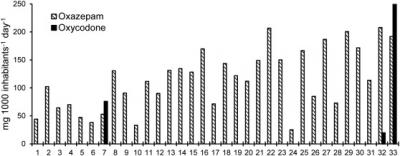Dec 19 2013
Chemists at Umeå University in Sweden have been able to trace narcotics substances and prescription drugs in measurements of wastewater from 33 Swedish sewage treatment plants. Cocaine, amphetamine, and methamphetamine, in measurable concentrations, were found in a total of half of the locations.
 One of the four benzodiazepines included in this study, oxazepam, a short-acting benzodiazepine used legally in Sweden, was detected in all STPs (33/33) in the range from 20 to 200 mg (1,000 inhabitants). Credit: Department of Chemistry, Umeå University, Sweden
One of the four benzodiazepines included in this study, oxazepam, a short-acting benzodiazepine used legally in Sweden, was detected in all STPs (33/33) in the range from 20 to 200 mg (1,000 inhabitants). Credit: Department of Chemistry, Umeå University, Sweden
When a person consumes a drug it is excreted through the digestive system, either unchanged or as metabolites through the body and ends up in the wastewater. Through taking a sample of water in treatment plants and measuring the levels of drugs can provide a snapshot of the drug usage in a particular city. The method has been used before, both in Sweden and abroad, and is a complement to other methods to estimate drug use in society.
"What is unique about our study is its scope and this is the first time this method has been used to screen the entire country for drugs," says Marcus Östman, who led the study and is a PhD student at the Department of Chemistry at Umeå University.
"Previous measurements in Sweden have only applied to single locations and a limited number of substances. In addition, we have developed a faster and more cost-effective measurement to conduct this type of research."
The measurements were performed on one day in January 2012. The concentrations were generally low when compared with similar studies from other European countries.
"The results were quite expected, but the variations between different places and different parts of Sweden was surprisingly large," says Marcus Östman. "For instance, some smaller municipalities had fairly high levels of the dangerous drug methamphetamine. Since we measure using a chemical scale, it is no problem to distinguish methamphetamine from amphetamine."
The research team found the remains of a total of 13 different narcotic substances in the incoming wastewater of the investigated Swedish treatment plants. The most common substances were used as medicine: oxazepam (anti-anxiety), codeine (painkiller), morphine (pain reliever) and tramadol (analgesic). These substances were found in all treatment plants in the study.
Of the illicit non-prescription drugs included in the study, the following were detected in the sewage water samples: cocaine (12 locations), amphetamines (13 locations), and methamphetamine (16 locations). Heroin, ecstasy or LSD could not be detected.
The highest level of cocaine and amphetamine were found in Gothenburg, the largest city in the study. The researches then detected a different pattern.
Methamphetamine content seemed not to be correlated to the size of the city in any way. The municipality of Köping had the highest concentration of methamphetamine. The smaller municipalities of Bollebygd and Lycksele generally had fewer detected drugs and in lower concentrations compared to other cities.
"Tracking of wastewater is a new effective tool which is interesting from a public health perspective," states Marcus Östman. "It's a much faster way to get an overview of drug use than the classical indirect methods like confiscations at customs and surveys. For example, we might see if a new drug arrived in a city."